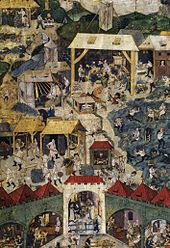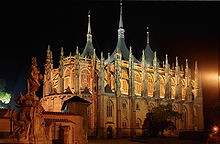Kutná Hora
Template:Geobox Kutná Hora (Czech pronunciation: [ˈkutnaː ˈɦora] ; medieval Czech: Hory Kutné; German: Kuttenberg) is a town in the Central Bohemian Region of the Czech Republic.
History
The town began in 1142 with the settlement of Sedlec Abbey, the first Cistercian monastery in Bohemia, Sedlec Monastery, brought from the Imperial immediate Cistercian Waldsassen Abbey. By 1260, German miners began to mine for silver in the mountain region, which they named Kuttenberg, and which was part of the monastery property. The name of the mountain is said to have derived from the monks' cowls (the Kutten) or from the word mining (kutání in old Czech). Under Abbot Heidenreich, the territory greatly advanced due to the silver mines which gained importance during the economic boom of the 13th century.
The earliest traces of silver have been found dating back to the 10th century, when Bohemia already had been in the crossroads of long-distance trade for many centuries. Silver dinars have been discovered belonging to the period between 982–995 in the settlement of Malín, which is now a part of Kutná Hora.

From the 13th to 16th centuries, the city competed with Prague economically, culturally, and politically.[1] Since 1995, the city center has been a UNESCO World Heritage Site.[2]
In 1300, King Wenceslaus II of Bohemia issued the new royal mining code Ius regale montanorum (also known as Constitutiones Iuris Metallici Wenceslai II). This was a legal document that specified all administrative as well as technical terms and conditions necessary for the operation of mines.[3] The city developed with great rapidity, and at the outbreak of the Hussite Wars in 1419 was the second most important city in Bohemia, after Prague, having become the favourite residence of several Bohemian kings. It was here that, on January 18, 1409, Wenceslaus IV signed the famous Decree of Kutná Hora, by which the Czech university nation was given three votes in the elections to the faculty of Prague University as against one for the three other nations.
In 1420, Emperor Sigismund made the city the base for his unsuccessful attack on the Taborites during the Hussite Wars, leading to the Battle of Kutná Hora. Kuttenberg (Kutná Hora) was taken by Jan Žižka, and after a temporary reconciliation of the warring parties was burned by the imperial troops in 1422, to prevent its falling again into the hands of the Taborites. Žižka nonetheless took the place, and under Bohemian auspices it awoke to a new period of prosperity.
Along with the rest of Bohemia, Kuttenberg (Kutná Hora) passed to the Habsburg Monarchy of Austria in 1526. In 1546, the richest mine was severely flooded. In the insurrection of Bohemia against Ferdinand I the city lost all its privileges. Repeated visitations of the plague and the horrors of the Thirty Years' War completed its ruin. Half-hearted attempts after the peace to repair the ruined mines failed; the town became impoverished, and in 1770 was devastated by fire. The mines were abandoned at the end of the 18th century.
In this town, Prague groschen were minted between 1300–1547/48.




Bohemia was a crownland of the Austrian Empire in 1806, in the Austrian monarchy (Austria side) after the compromise of 1867). Until 1918, Kuttenberg was the capital of the district of the same name, one of the 94 Bezirkshauptmannschaften in Bohemia.[4]
Together with the rest of Bohemia, the town became part of the newly founded Czechoslovakia after World War I and the collapse of Austria-Hungary. Kutná Hora was incorporated into the Protectorate of Bohemia and Moravia by Nazi Germany in the period 1939–1945, but was restored to Czechoslovakia after World War II. The town became part of the Czech Republic in 1993, after the dissolution of Czechoslovakia.
Notable residents
- Jakob Jakobeus, Slovak writer
- Jan Erazim Vocel, poet, archaeologist, historian and cultural revivalist
- František Zelenka, architect, graphic, stage set and costume designer
- Terry Guo, founder of Taiwanese company Foxconn, in 2002 he bought a Roztěž castle near Kutná Hora[5]
Architecture
The centre of Kutná Hora and Sedlec Abbey with its famous ossuary are a UNESCO World Heritage Site. Among the most important buildings in the town are the Gothic, five-naved St. Barbara's Church, begun in 1388, and the Italian Court, formerly a royal residence and mint, which was built at the end of the 13th century. The Gothic Stone Haus, which since 1902 has served as a museum, contains one of the richest archives in the country. The Gothic St. James's Church, with its 86-metre (282 ft) tower, is another prominent building. Sedlec is the site of the Gothic Cathedral of Our Lady and the famous Ossuary.
Main sights
- Church of St. Barbara (Chrám Svaté Barbory)
- Church of Our Lady (Chrám Nanebevzetí Panny Marie)
- Sedlec Ossuary (Sedlecká kostnice)
- Church of St. James (Kostel sv. Jakuba)
- Church of St. John Nepomuk (Kostel sv. Jana Nepomuckého)
- Church of Ursuline Convent (Klášter řádu sv.Voršily)
- Jesuit College (Jezuitská kolej)
- Italian Court (Vlašský dvůr)
- Marian column (Morový sloup)
Gallery
-
St. Barbara street along Jesuit College
-
St. Barbara Church
-
Stained glass in the Church of St. Barbara
-
Palackého Square
-
St. Barbara's Church and Jesuit College
-
Bones inside Sedlec Ossuary
-
St. James Church
-
Black Death memorial
International relations
Twin towns — Sister cities
Kutná Hora is twinned with:
 Bamenda, Cameroon
Bamenda, Cameroon Bingen am Rhein, Germany
Bingen am Rhein, Germany Eger, Hungary
Eger, Hungary Fidenza, Italy
Fidenza, Italy Jinan, China
Jinan, China Kamianets-Podilskyi, Ukraine
Kamianets-Podilskyi, Ukraine Kremnica, Slovakia
Kremnica, Slovakia Reims, France
Reims, France Ringsted, Denmark
Ringsted, Denmark Stamford, United Kingdom
Stamford, United Kingdom Tarnowskie Góry, Poland
Tarnowskie Góry, Poland
See also
- Deer Park Žehušice – natural reserve with white deer, located 15 km (9 mi) to the east
References
- ^ "Discover Czech". Retrieved 2007-03-07.
- ^ "UNESCO page on Kutná Hora". Retrieved 2007-03-07.
- ^ "Town history". Retrieved 2007-03-07.
- ^ Die postalischen Abstempelungen auf den österreichischen Postwertzeichen-Ausgaben 1867, 1883 und 1890, Wilhelm KLEIN, 1967
- ^ He spent £21m on a penthouse - but turns lights off to save money: Inside the amazing world of secret billionaire Terry Guo Daily Mail 26 June 2010
External links
- Municipal website
 Kutná Hora travel guide from Wikivoyage
Kutná Hora travel guide from Wikivoyage- Photo Gallery of Kutná Hora and Travel Information









